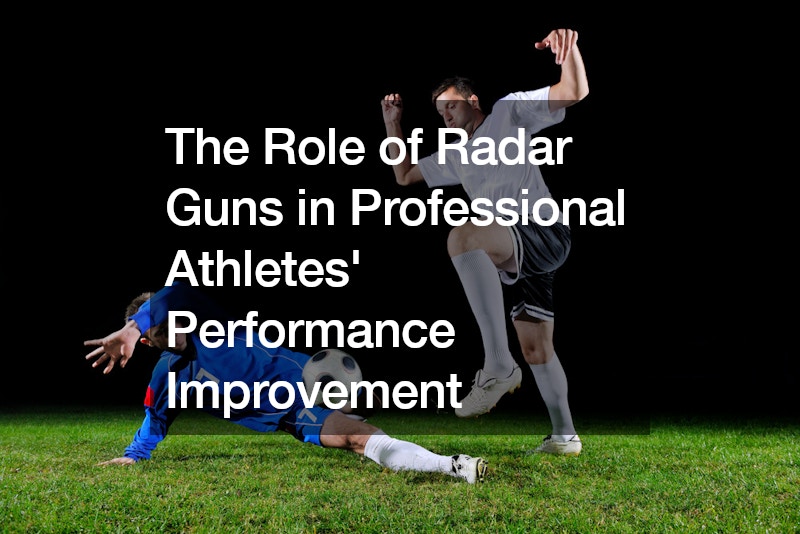In the world of professional sports, precision and data are critical elements that drive performance improvement. Among the many tools available to athletes and coaches, the radar gun stands out as a versatile and indispensable device. Its application spans various sports, providing real-time, accurate measurements that are essential for performance analysis and enhancement.
This article explores the significant role that radar guns play in professional athletes’ performance improvement, highlighting their impact across different sports disciplines.
Enhancing Pitching and Hitting in Baseball
In baseball, the radar gun is synonymous with measuring pitch velocity. Pitchers use radar guns to track the speed of their throws, allowing them to make necessary adjustments to their mechanics and techniques. Understanding the speed and consistency of pitches helps pitchers refine their performance, aiming for optimal velocity while maintaining control and accuracy. For example, a pitcher might adjust their grip or throwing motion based on the feedback from a radar gun to maximize speed without compromising on precision.
Similarly, batters benefit from radar guns by analyzing the exit velocity of their hits. Higher exit velocities often correlate with better contact and power, providing batters with data to fine-tune their swings. By understanding the mechanics that lead to higher exit velocities, hitters can work on specific aspects of their swing to improve their overall performance.
Optimizing Serve Speed in Tennis
Tennis players, particularly servers, rely heavily on the radar gun to measure the speed of their serves. Serve speed is a critical component of a player’s arsenal, often dictating the flow of the game and putting pressure on opponents. By using radar guns during practice, players can experiment with different serving techniques to achieve higher speeds while maintaining accuracy and consistency.
Coaches also use radar gun data to analyze the biomechanics of their players’ serves. By correlating serve speed with other performance metrics, they can identify areas for improvement and implement targeted training regimens. This approach not only helps in increasing serve speed but also enhances overall serve effectiveness.
Improving Sprint Performance in Track and Field
In track and field, particularly in sprinting events, the radar gun is employed to measure an athlete’s speed at various points during their run. This data is crucial for understanding how an athlete accelerates and maintains speed, providing insights into their sprinting mechanics. Coaches use this information to develop training programs that focus on improving acceleration phases and sustaining top speeds.
Athletes can monitor their progress over time, using radar gun data to set benchmarks and goals. By continuously refining their technique based on speed measurements, sprinters can achieve incremental improvements that translate into better race performance.
Advancing Skills in Soccer and Hockey
In sports like soccer and hockey, radar guns are used to measure the speed of shots and passes. For soccer players, the speed of a shot can be the difference between scoring a goal and missing the target. By using radar guns in training, players can work on their shooting technique to increase shot speed while maintaining accuracy. This data-driven approach helps in refining skills that are critical during match situations.
Hockey players similarly use radar guns to measure the speed of their shots. High-velocity shots are harder for goalies to stop, making shot speed a valuable asset. By incorporating radar gun feedback into their training, players can develop more powerful and effective shots.
Integrating Radar Guns into Comprehensive Training Programs
The versatility of radar guns extends beyond individual use; they are also integral to comprehensive training programs. Teams and coaches use radar guns to collect data across multiple training sessions, creating detailed performance profiles for each athlete. This data-driven approach enables the identification of performance trends, strengths, and areas for improvement.
By combining radar gun data with other performance metrics, such as heart rate and biomechanical analysis, coaches can develop holistic training plans that address all aspects of an athlete’s development. This integration of technology ensures that athletes receive targeted and effective training, maximizing their potential.
Conclusion
Radar guns have become an essential tool in the arsenal of professional athletes and coaches. Their ability to provide precise, real-time data allows for detailed performance analysis and targeted improvements across various sports disciplines. From enhancing pitch velocity in baseball to optimizing serve speed in tennis and improving sprint performance in track and field, radar guns play a pivotal role in helping athletes reach their full potential. As technology continues to advance, the application of radar guns in sports training is likely to expand, offering even greater opportunities for performance enhancement.
.


